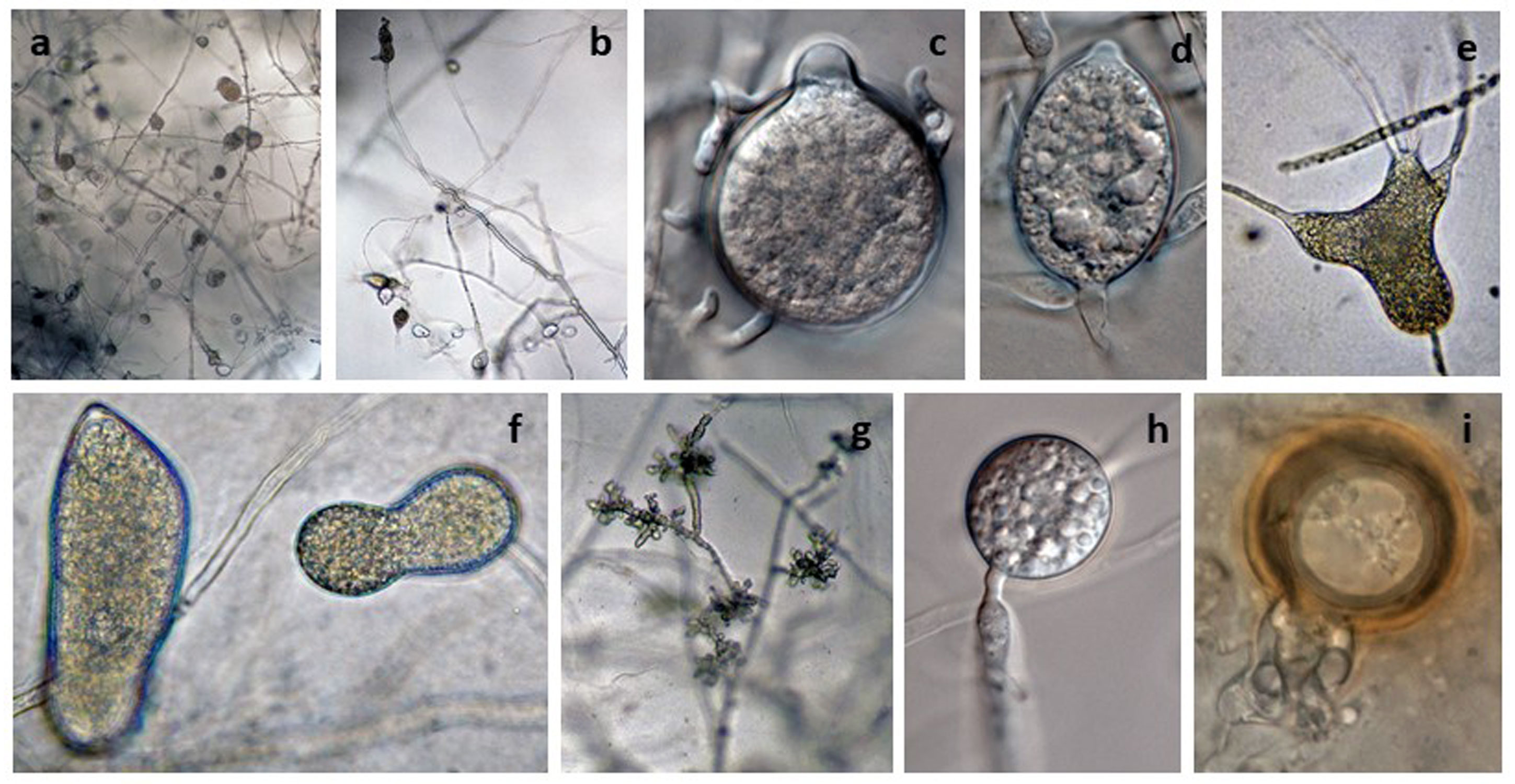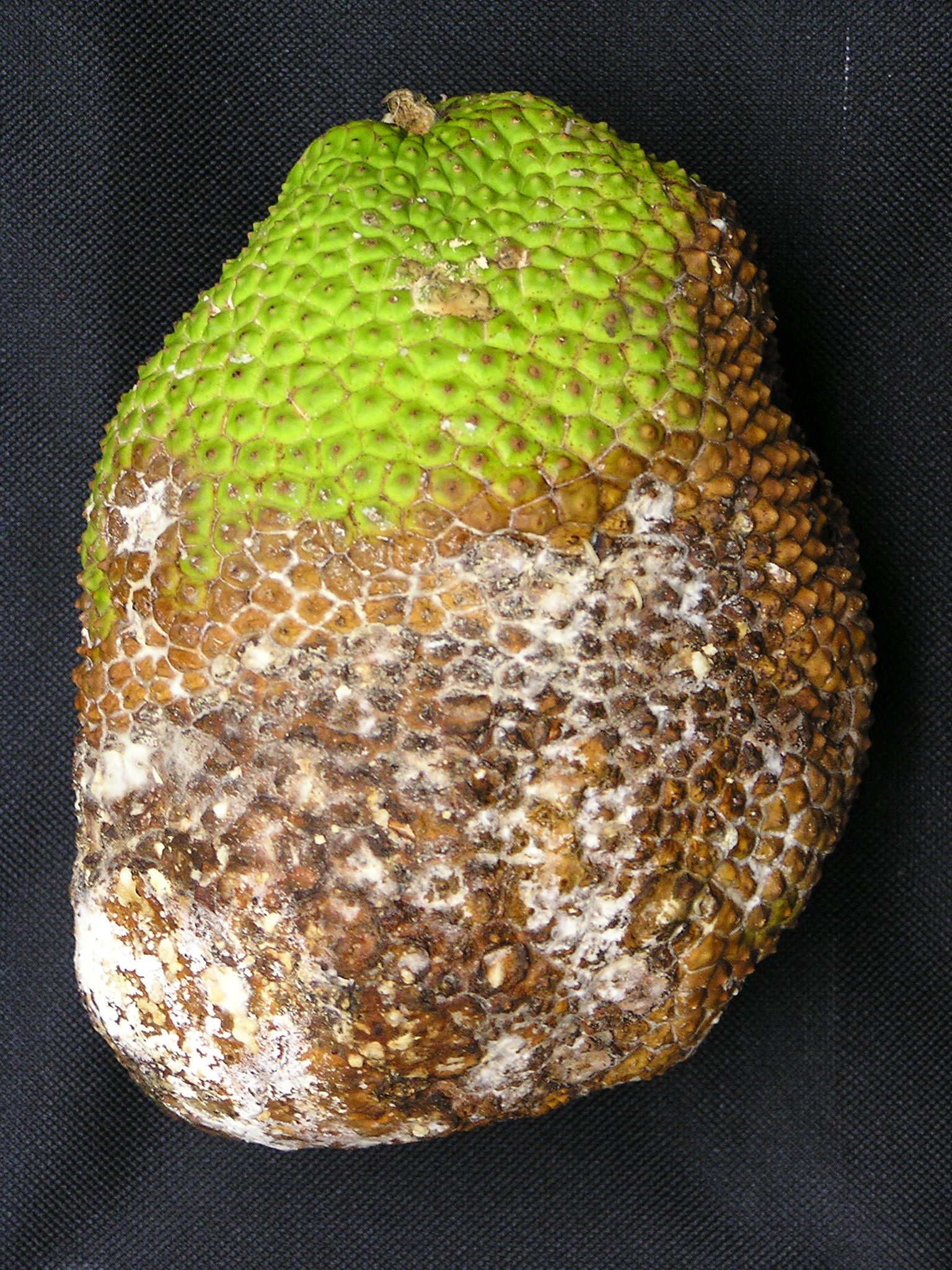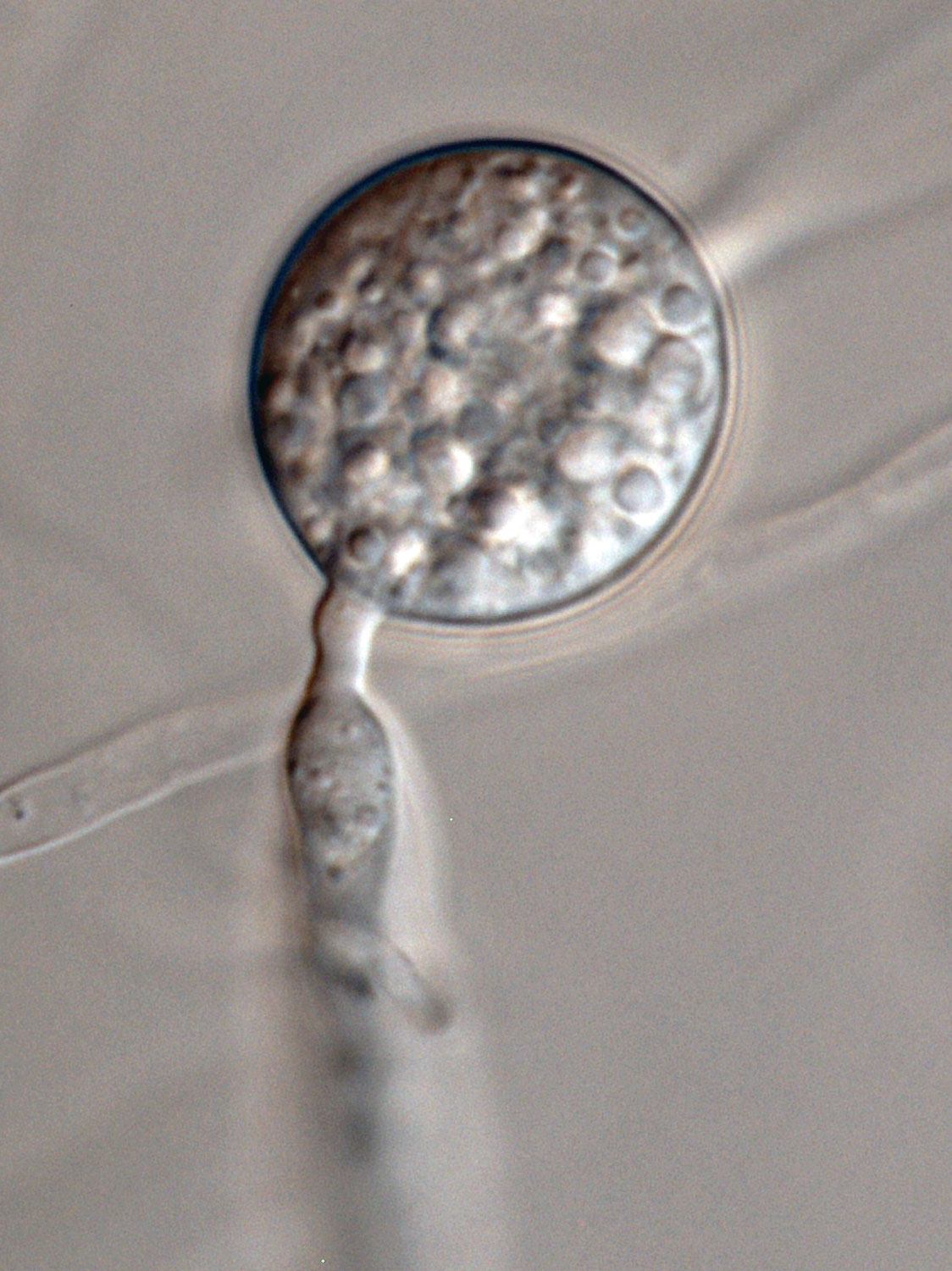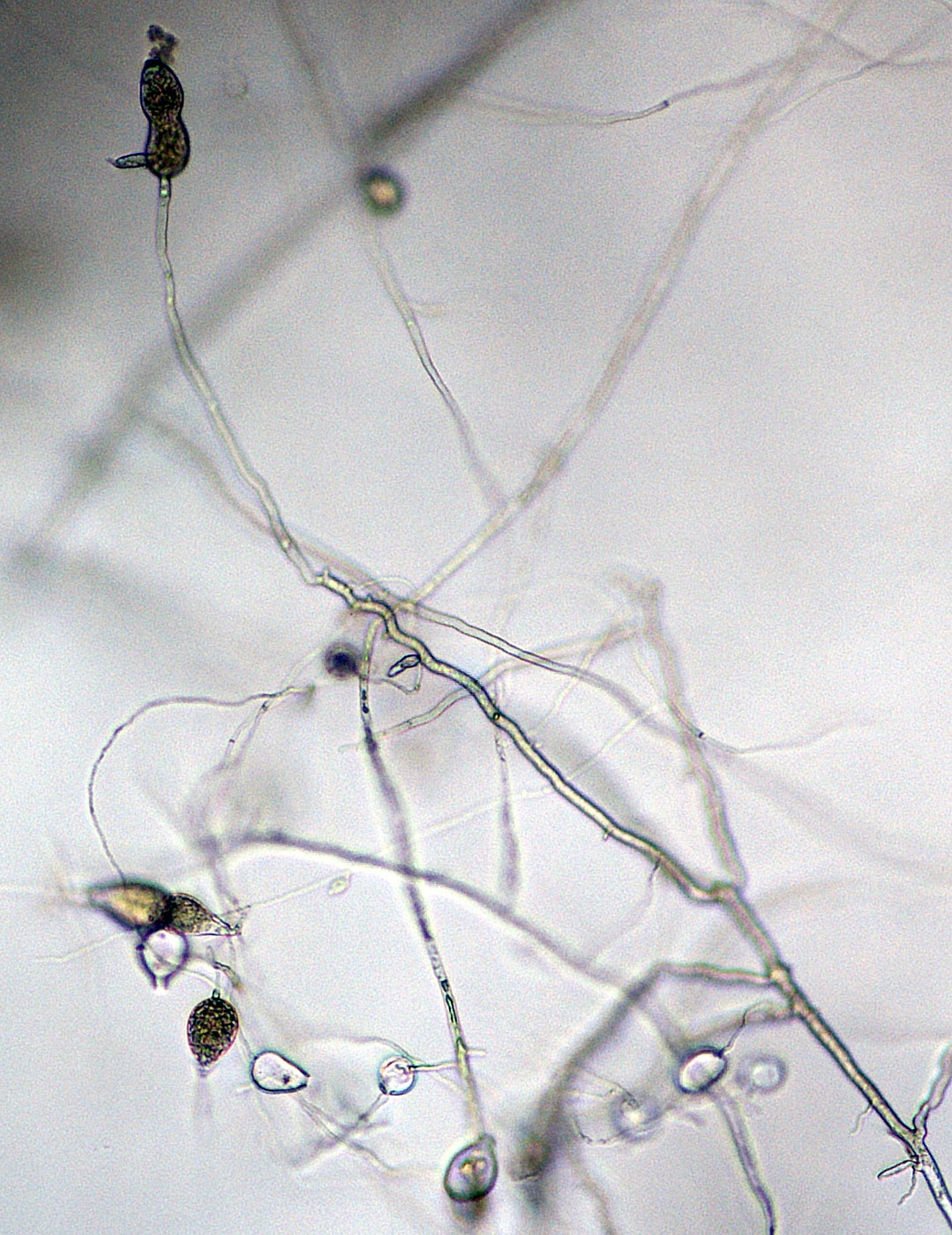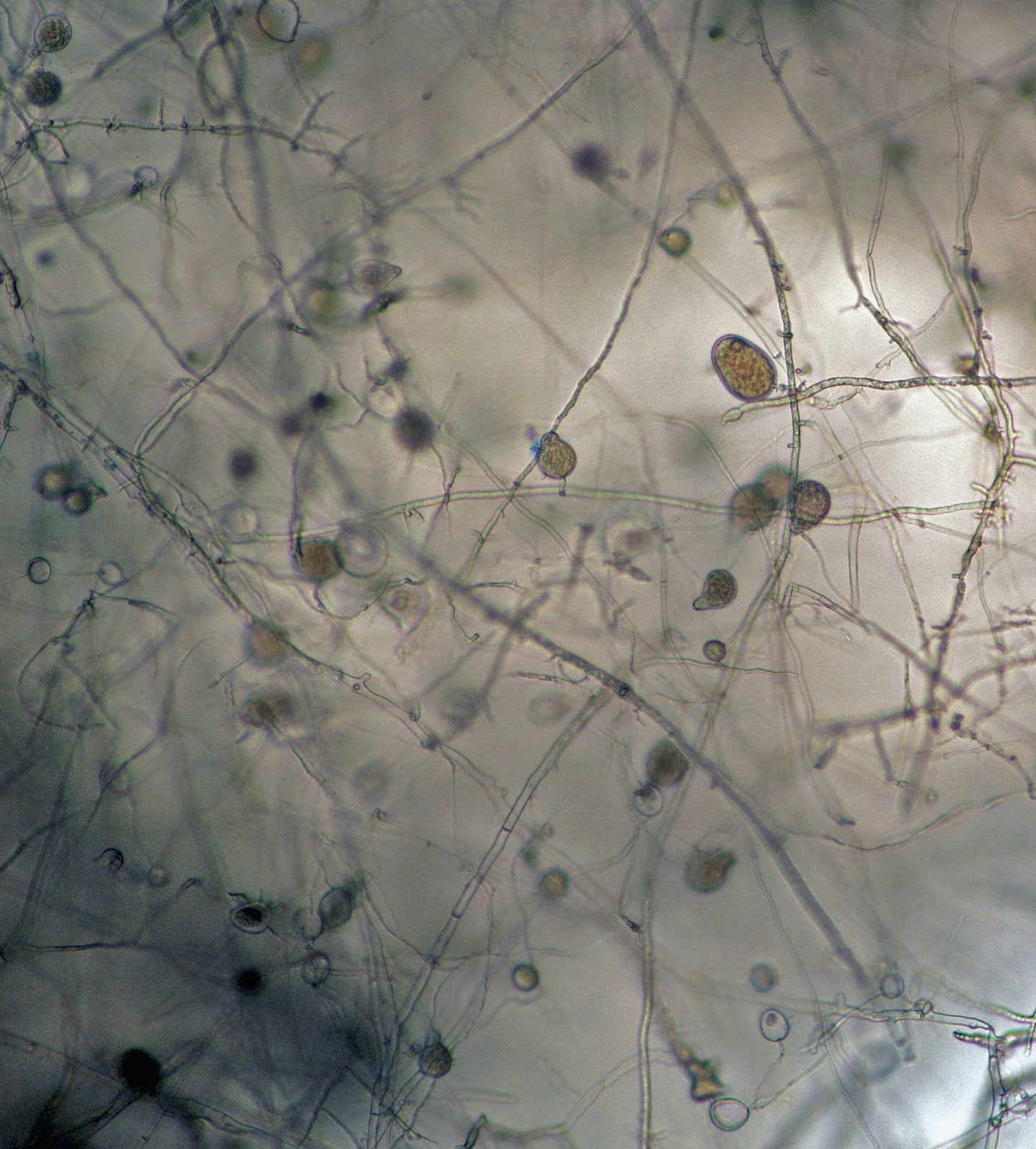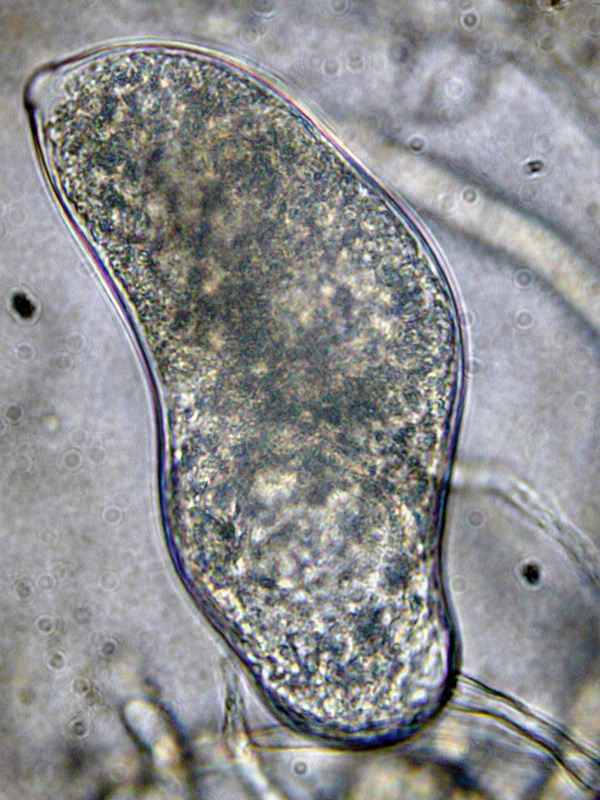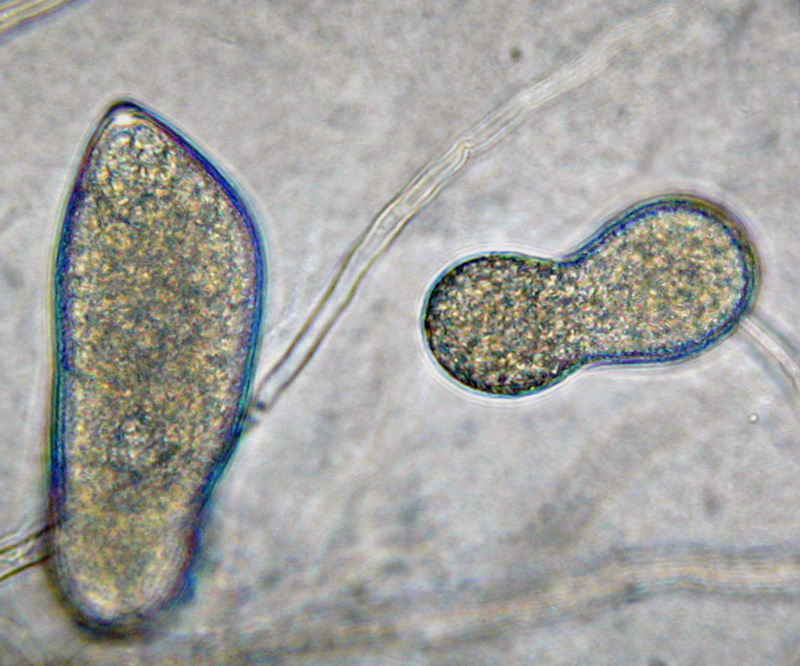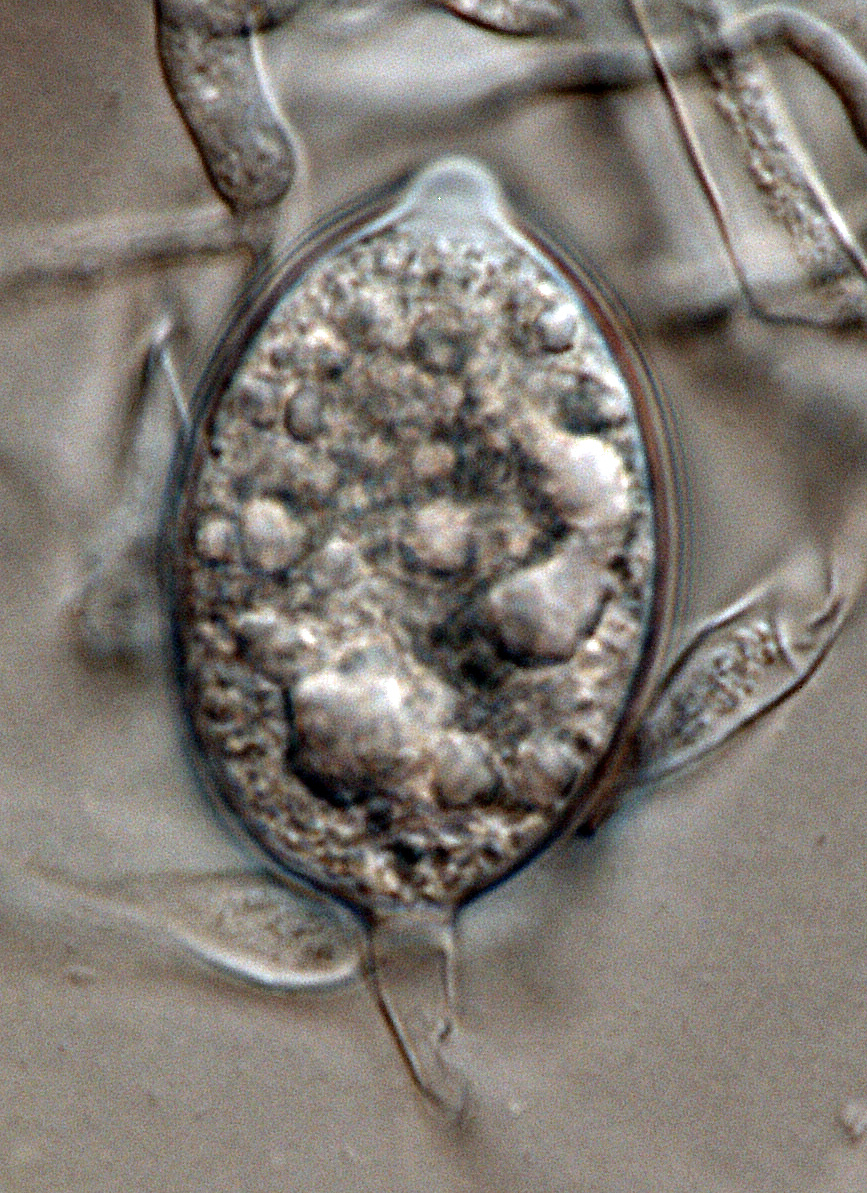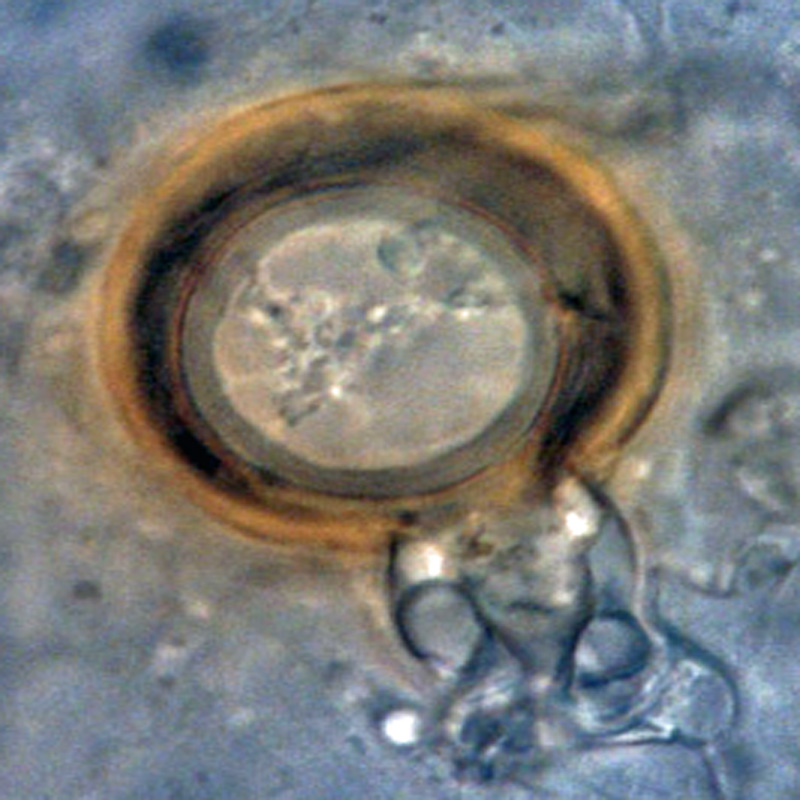Phytophthora nicotianae (in progress - Abad et al. 2023b)
|
Phytophthora spp. in subclade 1d: portion of the seven-loci ML phylogeny featuring the type cultures of 212 described species (by T. Bourret). Notice the position of P. nicotianae selected specimen CBS 149823 = S&T BL 162. Gloria Abad, USDA S&T.
|
|
Phytophthora spp. in subclade 1d: Morphological Tabular key (PDF) and Tabular key legends (PDF) in IDphy2 KEY SECTION. Notice the data of P. nicotianae selected specimen CBS 149823 = S&T BL 162. Gloria Abad, USDA S&T.
|
|
Phytophthora nicotianae (CPHST BL 44) colonies of the selected specimen grown for 7 days on (a) V8® Agar, (b) potato dextrose agar, and (c) malt extract agar; photo by Clinton Greub, Krysta Jennings, and Leandra Knight, USDA-APHIS-PPQ |
|
Phytophthora nicotianae (CPHST BL 161) colonies of a selected specimen grown for 7 days on (a) V8® Agar, (b) potato dextrose agar, and (c) malt extract agar; photo by Krysta Jennings and Leandra Knight, USDA-APHIS-PPQ |
|
Phytophthora nicotianae (CPHST BL 162) colonies of a selected specimen grown for 7 days on (a) V8® Agar, (b) potato dextrose agar, and (c) malt extract agar; photo by Krysta Jennings and Leandra Knight, USDA-APHIS-PPQ |
|
Phytophthora nicotianae (CPHST BL 44, selected specimen) asexual phase (a–h) and sexual phase (i): (a, b) sporangia originated in simple sympodial sporangiophore, (c, d) papillated sporangia, (d) caducous with short pedicel, (e, f) sporangia with irregular shapes, (g) hyphal swellings, (h) chlamydospore, (i) oogonium with amphigynous antheridium and aplerotic oospore; photos by Gloria Abad, USDA-APHIS-PPQ. |
|
Breadfruit blight caused by Phytophthora nicotianae; photo by Scot Nelson, University of Hawaii at Manoa. |
|
Phytophthora nicotianae (CPHST BL 44, selected specimen) asexual phase: chlamydospore; photo by Gloria Abad, USDA-APHIS-PPQ. |
|
Phytophthora nicotianae (CPHST BL 44, selected specimen) asexual phase: hyphal swellings; photo by Gloria Abad, USDA-APHIS-PPQ. |
|
Phytophthora nicotianae (CPHST BL 44, selected specimen) asexual phase: sporangia originated in simple sympodial sporangiophores; photo by Gloria Abad, USDA-APHIS-PPQ. |
|
Phytophthora nicotianae (CPHST BL 44, selected specimen) asexual phase: sporangia originated in simple sympodial sporangiophores; photo by Gloria Abad, USDA-APHIS-PPQ. |
|
Phytophthora nicotianae (CPHST BL 44, selected specimen) asexual phase: sporangium with irregular shape; photo by Gloria Abad, USDA-APHIS-PPQ. |
|
Phytophthora nicotianae (CPHST BL 44, selected specimen) asexual phase: sporangium with irregular shape; photo by Gloria Abad, USDA-APHIS-PPQ. |
|
Phytophthora nicotianae (CPHST BL 44, selected specimen) asexual phase: sporangia with irregular shapes; photo by Gloria Abad, USDA-APHIS-PPQ. |
|
Phytophthora nicotianae (CPHST BL 44, selected specimen) asexual phase: papillated sporangium; photo by Gloria Abad, USDA-APHIS-PPQ. |
|
Phytophthora nicotianae (CPHST BL 44, selected specimen) sexual phase: oogonium with amphigynous antheridium and aplerotic oospore; photo by Gloria Abad, USDA-APHIS-PPQ. |
Name and publication
Phytophthora nicotianae Breda de Haan (1896)
Breda de Haan van. 1896. De bibitziekte in de Deli-tabak veroorzaakt door Phytophthora nicotianae. Meded. uit 's Lands Plantentuin Coll. XV (met plaat) Batavia 15: 1–107 (pg 57).
Nomenclature
Mycobank
Synonymy
≡ Phloeophthora nicotianae (Breda de Haan) G.W. Wilson, Mycologia 6 (2): 80 (1914) [MB#246601]
≡ Phytophthora parasitica var. nicotianae (Breda de Haan) Tucker, Research Bulletin of the Missouri Agricultural Experiment Station 153: 173 (1931) [MB#253828]
= Phytophthora manoana Sideris [MB#122828]
= Phytophthora melongenae var. ananaphthoros Sideris [MB#494136]
= Phytophthora parasitica Dastur, Memoirs of the Department of Agriculture India 5 (4): 177 (1913) [MB#194284]
= Phytophthora melongenae Sawada, Special Report Agric. Exp. Stat. (Taiwan): 77 (1915) [MB#232247]
= Phytophthora terrestris Sherb., Phytopathology 7: 127 (1917) [MB#194200]
= Phytophthora parasitica var. rhei G.H. Godfrey, J. Agric. Res.: 21 (1923) [MB#273614]
= Phytophthora tabaci Sawada, Report of the Department of Agriculture Government Research Institute of Formosa 27: 35 (1927) [MB#279692]
Typification
from Breda de Haan (1896)
Type: SUMATRA (island in western Indonesia) Java, Borneo in leaves of Nicotiana tabaccum
Ex-type: LOST
Well-authenticated specimen(s) selected by Gloria Abad:
- Selected specimen #1: CPHST BL 44 = P7661 (WPC) (A1) (Indonesia, Nicotiana tabacum)
- Selected specimen #2: CPHST BL 162 = P6303 (WPC) (A2) (Indonesia, Gramatophyllum sp.)
- Selected specimen #3: CPHST BL 161 = P1753 (WPC) (A1) (Australia, Nicotiana tabacum)
Selected specimen #1 in other collections:
(SE) CBS 149823, NRRL 64371, WPC P6303, S&T BL 162 (Abad)
Molecular identification
Voucher sequences for barcoding genes (ITS rDNA and COI) of the selected specimen (see Molecular protocols page)
Phytophthora nicotianae isolate CPHST BL 44 (= P7661 WPC) = ITS rDNA MG865550, COI MH136943
Voucher sequences for Molecular Toolbox with seven genes (ITS, β-tub, COI, EF1α, HSP90, L10, and YPT1
(see Molecular protocols page) (In Progress)
Voucher sequences for Metabarcoding High-throughput Sequencing (HTS) Technologies [Molecular Operational Taxonomic Unit (MOTU)]
(see Molecular protocols page) (In Progress)
Sequences with multiple genes for selected specimen in other sources
- NCBI: Phytophthora nicotianae CPHST BL 44
- EPPO-Q-bank: Phytophthora nicotianae
- BOLDSYSTEMS: Phytophthora nicotianae (barcoding COI & ITS)
Position in multigenic phylogeny with 7 genes (ITS, β-tub, COI, EF1α, HSP90, L10, and YPT1)
Clade clade:
a taxonomic group of organisms classified together on the basis of homologous features traced to a common ancestor
1d
Genome sequence
Phytophthora nicotianae strain selected specimen BL 162. Accession genome USDA_Pnic_BL162_1.0, BioProject PRJNA605765, USDA-APHIS-PPQ-S&T (2020), Srivastava et al 2022
Morphological identification
Colonies and cardinal temperatures
Colony colony:
assemblage of hyphae which usually develops form a single source and grows in a coordinated way
morphology on V-8 agar and potato dextrose agar with no distinct pattern with coralloid edges, and malt extract agar with slow growth. Minimum temperature for growth 9°C, optimum 24°C, maximum 33°C.
Conditions for growth and sporulation
Asexual phase
SporangiaSporangia:
sac within which zoospores form, especially when water is cooled to about 10°C below ambient temperature; in solid substrates, sporangia usually germinate by germ tubes
papillatepapillate:
pertaining to the production of a distinct papilla at the distal end of the sporangium (cf. nonpapillate and semipapillate)
; persistentpersistent:
pertaining to sporangia that remain attached to the sporangiophore and do not separate or detach easily (cf. caducous)
and caducouscaducous:
pertaining to sporangia that become dislodged readily (i.e. deciduous) and separate from the sporangiophore (cf. persistent)
with short pedicels (1–4 µm); ovoidovoid:
egg-shaped, with the widest part at the base of the sporangium and the narrow part at the apex
, globoseglobose:
having a rounded form resembling that of a sphere
, obovoidobovoid:
inversely egg-shaped; ovoid, but with the widest part at the apex
, obpyriformobpyriform:
inversely pear-shaped, i.e. with the widest part at the point of attachment (cf. pyriform)
, and with irregular shapes (15–64 L x 11–47 W µm), some sporangiasporangia:
sac within which zoospores form, especially when water is cooled to about 10°C below ambient temperature; in solid substrates, sporangia usually germinate by germ tubes
with elongated necks and tapered bases; sporangiasporangia:
sac within which zoospores form, especially when water is cooled to about 10°C below ambient temperature; in solid substrates, sporangia usually germinate by germ tubes
originated in simple sympodial sporangiophores. Hyphal swellings globoseglobose:
having a rounded form resembling that of a sphere
, subglobose, intercalaryintercalary:
positioned within a hypha (cf. terminal)
, many times with radiating hyphaehyphae:
single, tubular filament of a fungal or oomycete thallus; the basic structural unit of a fungus or oomycete
. ChlamydosporesChlamydospores:
an asexual spore with a thickened inner wall that is delimited from the mycelium by a septum; may be terminal or intercalary, and survives for long periods in soil
globoseglobose:
having a rounded form resembling that of a sphere
(15–43 µm), lateral, terminal, intercalaryintercalary:
positioned within a hypha (cf. terminal)
.
Sexual phase
Heterothallic. OogoniaOogonia:
the female gametangium in which the oospore forms after fertilization by the antheridium
smooth-walled (24–32 µm diam.); antheridiaantheridia:
the male gametangium; a multinucleate, swollen hyphal tip affixed firmly to the wall of the female gametangium (the oogonium)
amphyginous (9–21 x 10–15 µm); oospores predominantly apleroticaplerotic:
pertaining to a mature oospore that does not fill the oogonium; i.e. there is room left between the oospore wall and oogonium wall (cf. plerotic)
or slightly apleroticaplerotic:
pertaining to a mature oospore that does not fill the oogonium; i.e. there is room left between the oospore wall and oogonium wall (cf. plerotic)
(19–27 µm diam.).
Most typical characters
Phytophthora nicotianae is characterized by the asexual stage including the sporangiasporangia:
sac within which zoospores form, especially when water is cooled to about 10°C below ambient temperature; in solid substrates, sporangia usually germinate by germ tubes
, hyphal swellings, and chlamydosporeschlamydospores:
an asexual spore with a thickened inner wall that is delimited from the mycelium by a septum; may be terminal or intercalary, and survives for long periods in soil
, and the typical coralloid hyphaehyphae:
single, tubular filament of a fungal or oomycete thallus; the basic structural unit of a fungus or oomycete
observed in culture media.
Specimen(s) evaluated
Phytophthora nicotianae CPHST BL 44 = P7661 (World Phytophthora Collection)
Hosts and distribution
Distribution: cosmopolitan
Substrate: roots, stems, trunk, leaves, fruits, pods
Disease note: black shank of tobacco, damping-off, crown rot, leaf blight, fruit rot. See Erwin & Ribeiro for detailed disease notes by host.
Host: wide host range; 255 genera in 90 families
Retrieved January 31, 2018 from U.S. National Fungus Collections Nomenclature Database.
Additional Info:
Distribution: USA (CA, HI, TN), Bulgaria, Japan, Taiwan
Additional references and links
- SMML USDA-ARS: Phytophthora nicotianae
- EPPO Global Database: Phytophthora nicotianae var nicotianae
Phytophthora nicotianae var parasitica - Forest Phytophthorof the world: Phytophthora nicotianae
- CABI Digital Library: Phytophthora nicotianae
- Encyclopedia of Life (EOL): Phytophthora nicotianae
- Index Fungorum (IF): Phytophthora nicotianae
- Google All Phytophthora nicotianae
- Google Images Phytophthora nicotianae
- Google Scholar Phytophthora nicotianae
Fact sheet author
Z. Gloria Abad, Ph.D., USDA-APHIS-PPQ-S&T Plant Pathogen Confirmatory Diagnostics Laboratory (PPCDL), United States of America.




